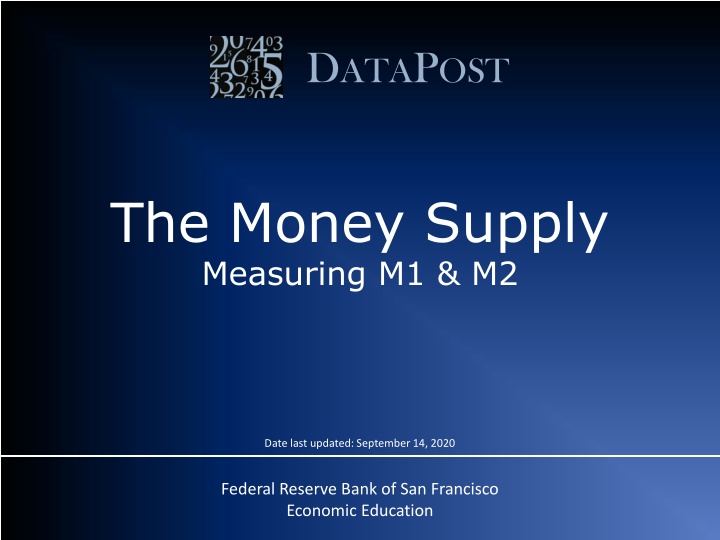
Money Supply Components and Trends
Explore the components and trends of the money supply, including M1 and M2 measurements, as well as detailed insights into savings deposits, time deposits, and money market funds. Learn how cash, checking accounts, and savings accounts contribute to M1 and M2, and analyze the evolving trends since 1980.
Download Presentation

Please find below an Image/Link to download the presentation.
The content on the website is provided AS IS for your information and personal use only. It may not be sold, licensed, or shared on other websites without obtaining consent from the author. If you encounter any issues during the download, it is possible that the publisher has removed the file from their server.
You are allowed to download the files provided on this website for personal or commercial use, subject to the condition that they are used lawfully. All files are the property of their respective owners.
The content on the website is provided AS IS for your information and personal use only. It may not be sold, licensed, or shared on other websites without obtaining consent from the author.
E N D
Presentation Transcript
DATAPOST The Money Supply Measuring M1 & M2 Date last updated: September 14, 2020 Federal Reserve Bank of San Francisco Economic Education
Money Supply Did You Know? M1 and M2 ($trillions, non-seasonally adjusted) Source: Federal Reserve Board By households and businesses To make payments and to be held as short-term investments $12 M2-M1 $10 $8.61 Used M1 $8 $6 M1 = coin and currency in circulation, plus checking accounts M2 = M1 plus short-term liquid assets $4.78 $3.22 $4 $1.54 Components $2 $0 1980 1990 2000 2010 The Fed uses M1 and M2 as a standardized way of defining money in the economy As a share of the total values shown above, M1 dropped from 26% in 1980 to 20% in 2010.1 Context 1. See PowerPoint file for technical note. DATAPOST www.frbsf.org/education/teacher-resources/datapost FRBSF Economic Education
Money Supply Components August 2020 ($trillions, seasonally adjusted) Source: Federal Reserve Board Savings Deposits Time Deposits Certain CDs Money Market Deposit Accounts Money Market Mutual Funds Includes M1 $20 M2 M2-M1 M1 $16 $12 $13.02 $8 Coin Currency Demand Deposits Travelers Checks M1 $4 $5.40 $5.40 $0 M1 M2 DATAPOST www.frbsf.org/education/teacher-resources/datapost FRBSF Economic Education
M2 in Detail August 2020 ($billions, seasonally adjusted) Savings Deposits, $11,548 Small-Denomination Time Deposits, $363 Retail Money Market Funds, $1,106 Currency and Coins, $1,913 M1 components of M2 Demand Deposits, $2,286 Other Checkable Deposits, $1,197 $0 $2,000 $4,000 $6,000 $8,000 $10,000 $12,000 $14,000 Source: Federal Reserve Board 9/10/20 data release Note: Components may not add to totals due to rounding DATAPOST www.frbsf.org/education/teacher-resources/datapost FRBSF Economic Education
Trends M1 and M2 Jan. 1980 to Aug. 2020 ($trillions, seasonally adjusted) $20 M2-M1 M1 $16 $12 M2 $8 $4 M1 $0 1980 1985 1990 1995 2000 2005 2010 2015 2020 Source: Federal Reserve Board 9/10/20 data release DATAPOST www.frbsf.org/education/teacher-resources/datapost FRBSF Economic Education
What Do You Think? 1. How much cash (coin + currency) do you currently have in your pocket, wallet, or purse? Is this cash part of M1 or M2? 2. Do you have a checking account? Is the balance in your checking account part of M1? 3. Do you have a savings account? Is your savings account balance part of M1? 4. How would you describe the trends of M1 and M2 since 1980? (See slide 5) DATAPOST www.frbsf.org/education/teacher-resources/datapost FRBSF Economic Education
